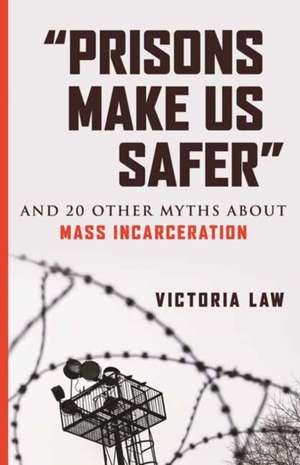Prisons Make Us Safer
Autor Victoria Lawen Limba Engleză Paperback – 5 apr 2021
2. Myths about prison
3. Misconceptions about incarcerated people
4. How to end mass incarceration Through carefully conducted research and interviews with incarcerated people, Law identifies the 21 key myths that propel and maintain mass incarceration, including: - The system is broken and we simply need some reforms to fix it
- Incarceration is necessary to keep our society safe
- Prison is an effective way to get people into drug treatment
- Private prison corporations drive mass incarceration "Prisons Make Us Safer" is a necessary guide for all who are interested in learning about the cause and rise of mass incarceration and how we can dismantle it.
Preț: 96.96 lei
Nou
Puncte Express: 145
Preț estimativ în valută:
18.56€ • 19.34$ • 15.45£
18.56€ • 19.34$ • 15.45£
Carte disponibilă
Livrare economică 16-30 decembrie
Livrare express 30 noiembrie-06 decembrie pentru 33.49 lei
Preluare comenzi: 021 569.72.76
Specificații
ISBN-13: 9780807029527
ISBN-10: 0807029521
Pagini: 240
Dimensiuni: 137 x 214 x 17 mm
Greutate: 0.32 kg
Editura: Beacon Press
ISBN-10: 0807029521
Pagini: 240
Dimensiuni: 137 x 214 x 17 mm
Greutate: 0.32 kg
Editura: Beacon Press
Notă biografică
Victoria Law
Cuprins
A Note on Language
Introduction
PART 1: WHAT DRIVES THE MASS INCARCERATION BOOM? MYTHS ABOUT THE CAUSE OF MASS INCARCERATION
CHAPTER 1
The system of mass incarceration is flawed and not working as designed (or, A brief history).
CHAPTER 2
We need prisons to make us safer.
CHAPTER 3
Prisons are places of rehabilitation.
CHAPTER 4
Private prison corporations drive mass incarceration.
CHAPTER 5
Private corporations and profit from prison labor drive mass incarceration.
CHAPTER 6
Race has nothing to do with mass incarceration (or, If people of color are disproportionately incarcerated, it’s because they commit more crimes).
CHAPTER 7
“Don’t do the crime if you can’t do the time.” People need to take personal responsibility for their actions.
PART 2: THE MYTHS OF PRISONS AS SERVICE PROVIDERS AND SAFETY NETS
CHAPTER 8
Jails and prisons provide people with needed mental health care.
CHAPTER 9
People in prison “jump the line” for life-saving medical care.
CHAPTER 10
Incarceration is an effective way to get people into drug treatment.
PART 3: THE INVISIBLE PEOPLE BEHIND THE WALLS
CHAPTER 11
Mass incarceration only affects Black cisgender men.
CHAPTER 12
Bringing up a history of abuse and violence is simply an “abuse excuse.”
CHAPTER 13
Mass incarceration and immigrant detention are unrelated issues that can be addressed separately.
PART 4: HOW DO WE END MASS INCARCERATION?
CHAPTER 14
Most people are in prison for nonviolent drug offenses. Let them out and we’ll end mass incarceration.
CHAPTER 15
People in prison don’t resist or organize against abusive conditions.
CHAPTER 16
Prisons keep us safe from murderers and rapists.
CHAPTER 17
Incarceration and sex offender registries are necessary to keep our children safe.
CHAPTER 18
The system is broken and we simply need some reforms to fix it.
CHAPTER 19
We should make our prisons more like those in Norway.
CHAPTER 20
Prisons are the only logical and evident way to address violent crime and meet the needs of victims.
CHAPTER 21
Even if societal and political conditions are to blame, there’s nothing we can do about it.
For Further Reading
Acknowledgments
Notes
Index
Introduction
PART 1: WHAT DRIVES THE MASS INCARCERATION BOOM? MYTHS ABOUT THE CAUSE OF MASS INCARCERATION
CHAPTER 1
The system of mass incarceration is flawed and not working as designed (or, A brief history).
CHAPTER 2
We need prisons to make us safer.
CHAPTER 3
Prisons are places of rehabilitation.
CHAPTER 4
Private prison corporations drive mass incarceration.
CHAPTER 5
Private corporations and profit from prison labor drive mass incarceration.
CHAPTER 6
Race has nothing to do with mass incarceration (or, If people of color are disproportionately incarcerated, it’s because they commit more crimes).
CHAPTER 7
“Don’t do the crime if you can’t do the time.” People need to take personal responsibility for their actions.
PART 2: THE MYTHS OF PRISONS AS SERVICE PROVIDERS AND SAFETY NETS
CHAPTER 8
Jails and prisons provide people with needed mental health care.
CHAPTER 9
People in prison “jump the line” for life-saving medical care.
CHAPTER 10
Incarceration is an effective way to get people into drug treatment.
PART 3: THE INVISIBLE PEOPLE BEHIND THE WALLS
CHAPTER 11
Mass incarceration only affects Black cisgender men.
CHAPTER 12
Bringing up a history of abuse and violence is simply an “abuse excuse.”
CHAPTER 13
Mass incarceration and immigrant detention are unrelated issues that can be addressed separately.
PART 4: HOW DO WE END MASS INCARCERATION?
CHAPTER 14
Most people are in prison for nonviolent drug offenses. Let them out and we’ll end mass incarceration.
CHAPTER 15
People in prison don’t resist or organize against abusive conditions.
CHAPTER 16
Prisons keep us safe from murderers and rapists.
CHAPTER 17
Incarceration and sex offender registries are necessary to keep our children safe.
CHAPTER 18
The system is broken and we simply need some reforms to fix it.
CHAPTER 19
We should make our prisons more like those in Norway.
CHAPTER 20
Prisons are the only logical and evident way to address violent crime and meet the needs of victims.
CHAPTER 21
Even if societal and political conditions are to blame, there’s nothing we can do about it.
For Further Reading
Acknowledgments
Notes
Index
